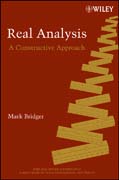
A unique approach to analysis that lets you apply mathematics across a range of subjectsThis innovative text sets forth a thoroughly rigorous modern account of the theoretical underpinnings of calculus: continuity, differentiability,and convergence. Using a constructive approach, every proof of every result is direct and ultimately computationally verifiable. In particular, existence is never established by showing that the assumption of non-existence leads to acontradiction. The ultimate consequence of this method is that it makes sense—not just to math majors but also to students from all branches of the sciences.The text begins with a construction of the real numbers beginning with the rationals, using interval arithmetic. This introduces readers to the reasoning and proof-writing skills necessary for doing and communicating mathematics, and it sets the foundation for the rest of the text, which includes:Early use ofthe Completeness Theorem to prove a helpful Inverse Function TheoremSequences, limits and series, and the careful derivation of formulas and estimates for important functionsEmphasis on uniform continuity and its consequences, such as boundedness and the extension of uniformly continuous functions from dense subsetsConstruction of the Riemann integral for functions uniformly continuous on an interval, and its extension to improper integralsDifferentiation, emphasizing the derivative as a function rather than a pointwise limitProperties of sequences and series of continuous and differentiable functionsFourier series and an introduction to more advanced ideas in functional analysisExamples throughout the text demonstrate the application of new concepts. Readers can test their own skills with problems and projects ranging in difficulty from basic to challenging.This book is designed mainly for an undergraduate course, and the author understands that many readers will not go on to more advanced pure mathematics. He therefore emphasizes an approach to mathematical analysis that can be applied across a range of subjects in engineering and the sciences. INDICE: PrefaceAcknowledgementsIntroduction0 Preliminaries0.1 The Natural Numbers0.2 The Rationals1 The Real Numbers and Completeness1.0 Introduction1.2Interval Arithmetic1.3Fine Families1.4Definition of the Reals1.5 Real Number Arithmetic1.6 Rational Approximations1.7 Real Intervals and Completeness1.8 Limits and Limiting FamiliesAppendix: The Goldbach Number and Trichotomy2 An Inverse Function Theorem and its Application2.0 Introduction2.1 Functions and Inverses2.2 An Inverse Function Theorem2.3 The Exponential Function2.4 Natural Logs and the Euler Number 33 Limits, Sequences and Series3.1 Sequences and Convergence3.2 Limits of Functions3.3 Series of NumbersAppendix I: Some Properties of Exp and LogAppendix II: Rearrangements of Series4 Uniform Continuity4.1 Definitions and elementary Properties4.2 Limits and ExtensionsAppendix I: Are there Non-Continuous Functions?Appendix II: Continuity of Double-Sided InversesAppendix III: The Goldbach Function5 The Riemann Integral5.1 Definition and Existence5.2 Elementary Properties5.3 Extensions and Improper Integrals6 Differentiation6.1 Definitions and Basic Properties6.2 The Arithmetic of Differentiability6.3 Two Important Theorems6.4 Derivative Tools6.5 Integral Tools7 Sequencesand Series of Functions7.1 Sequences and Functions7.2 Integrals and Derivatives o Sequences7.3 Power Series7.4 Taylor Series7.5 The Periodic FunctionsAppendix : Binomial Issues8 The Complex Numbers and Fourier Series8.0 Introduction8.1 The Complex Numbers C8.2 Complex Functions and Vectors8.3 Fourier Series TheoryReferencesIndex
- ISBN: 978-1-118-35706-4
- Editorial: John Wiley & Sons
- Encuadernacion: Rústica
- Páginas: 324
- Fecha Publicación: 19/04/2012
- Nº Volúmenes: 1
- Idioma: Inglés
